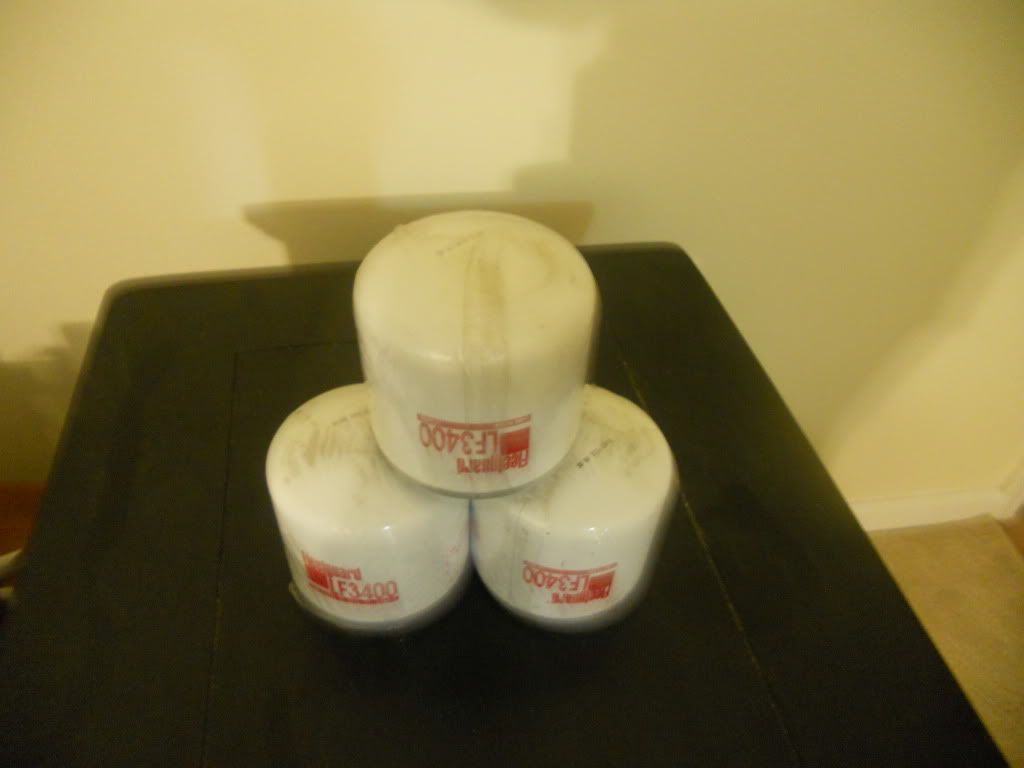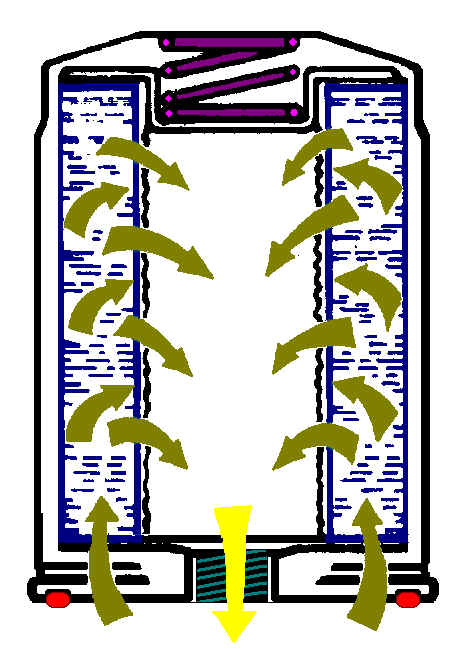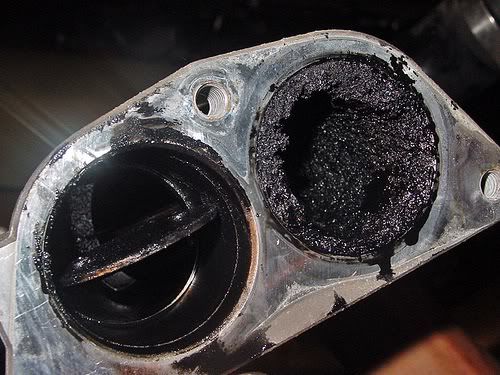Results 91 to 100 of 3899
-
 Tsikoteer
Tsikoteer

- Join Date
- Nov 2009
- Posts
- 3,509
April 12th, 2011 12:21 PM #91On the mann filter, the upper part has this spring and hole with rubber flaps pushing against the spring.
From my understanding, if the filter is clogged/ pressure is more than the BPV setting, that upper valve will open. This is contrary from closing/ blocking the inlet which you described causing totally blocked inlet and "no flow".
AFAIK the lower part is where the anti-drain back rubber is, same with BPV it is unidirectional and acts only when engine is stopped-when pressure is coming from the outlet going to the inlet (oil flow by gravity)..
I'L do some research on this but im completely sold out with fleetguard.. The lower BPV setting would not matter to me now because i change oil every 10k. Here's what i got, its the real deal but no box, just blister pack. Deym cheap, the FS 1/4 the price of OEM.
Deym cheap, the FS 1/4 the price of OEM.

-
April 12th, 2011 12:38 PM #92
The anti drain back valve keeps you from dry starting, that's it's job. It's one of the most important parts of the filter. Without an anti-drainback valve, oil must flow through and refill the oil filter before proper oil pressure is reached, the anit-drainback valve allows optimum oil pressure to be reached much quicker by keeping the oil filter filled with oil.
Well not going to do every filter because I just don't have time. But here's a good clue, plain cellulose element filters have the lowest filtering ability and dirt holding capacity. Resin treated ones have much better cleaning and the microglass version much higher.
Different filter makers also use different standards of efficiency and can be a bit murky on what test they used, ie is it multipi pass or single pass and what microns. You can email any filter maker and they will give you the rating of a particular filter. That's what I do. You can also find a lot on the net.
All filters have to undergo SAE (Society of Automotive Engineers) tests to verify that they meet the vehicle manufacturer's specifications. There are two tests available for automobile engine oil filters. All filters must be tested with the J806 test, but the new J1858 is much more meaningful. Currently the J1858 test is optional. Really, it's a way for high-end filter manufacturers to show off their great filters.
The SAE J806 test uses a single-pass test, checking for contaminant holding capacity, size of contaminant particles trapped, and ability to maintain clean oil. As an amendment of the J806 test, the multi-pass test also looks for filter life in hours, contaminant capacity in grams, and efficiency based on weight. The efficiency of the filter is determined only by weight through gravimetric measurement of the filtered test liquid. Typical numbers for paper filter elements are 85% (single pass) and 80% (multi-pass).
The SAE J1858 test provides both particle counting and gravimetric measurement to measure filter capacity and efficiency. Actual counts of contaminant particles by size are obtained every 10 minutes, both upstream (before the filter) and downstream (after the filter), for evaluation. From this data filtration ratio and efficiency for each contaminant particle size can be determined as well as dust capacity and pressure loss as a function of time. Typical numbers for paper element filters are 40% at 10 microns, 60% at 20 microns, 93% at 30 microns, and 97% at 40 microns.
Cummins diesel has it's own standards and it's 96.6% * 20 microns for it's engines. 98.7% at 35 microns. They have there own standards. Cummins makes Fleetguard. Baldwin are very close to Fleetguard in their standard but are just short on there specification but still a dang good filter.
But there are many good over the counter filters, like Purolator, (Mobil1 & K&N) are the same filter, Bosch are a good filter, Wix are great and I keep them on hand.
But if you want specific specs on a filter just email the company, there are different filter medias between filters, some are strait cellulose, some treated cellulose, some cellulose synthetic mix, and some microglass and then multi layer microglass and cellulose. Like I said a lot of different kinds. But OEM filters tend to be the cheapest crap out there.
-
April 12th, 2011 12:50 PM #93
Some filters have a combo anti drain back valve / bypass valve some are also at the top some bypass valves are on the bottom. Here's the way yours most likely works.
 When filter elements are clogged, the pressure builds up and pushes the top plates opening the bypass valve. When the bypass valve open, the oil flowed back to engine without filtration,
When filter elements are clogged, the pressure builds up and pushes the top plates opening the bypass valve. When the bypass valve open, the oil flowed back to engine without filtration,
The LF3400 fits the NAVARA and mulitple other vehicles with the 3/4 16 thread and has a 9.4psi BPV. I got like 6 cases of those hanging out in my storage got them for a killer deal so I had to buy em.
I have have only seen the TP oil filters they are messy as hell to change that is their downside for me. What is your fuel filter part number, Might look into seeing if I can score some. If you can do me a favor 12vdc let me know if the Navara has space for a little bit taller filter like 1".
By the way the Fleetguard fuel filters is a 10 micron element your factory is more like 40 microns. So a hell of a upgrade. Oh yeah how much for each filter?
The LF3400 I have are also from the France factory, I guess that's just were this particular one is made. .

Last edited by dvldoc; April 12th, 2011 at 01:22 PM.
-
 Verified Tsikot Member
Verified Tsikot Member

- Join Date
- Jan 2011
- Posts
- 123
-
 Tsikoteer
Tsikoteer

- Join Date
- Nov 2009
- Posts
- 3,509
April 12th, 2011 02:11 PM #95LF3400 php650 (one shop at 400+ cant verify though if real deal) But what amazes me is FS19594 at 500php wc CASAs Man is selling at 2350

I cant find the equivalent for primary fuel filter but im sure its the same used in TD42 Patrols and older Frontier - WiF sensor not included.

Lotsa space on the secondary, but tight down in the primary. Maybe mounting it elsewhere will fit my planned upgrade..
Heres the pic from my file (lazy me its so hoott otside), taken during my aircon drain-hose mod.
its so hoott otside), taken during my aircon drain-hose mod.

-
-
April 12th, 2011 02:37 PM #97
* DAGOL
I would also like to mention I am a ASE Certified Master Mechanic and have been doing this for almost 20 years with a ton of specialty certs and training. I also run a company that deals with automotive performance. I only deal in facts not marketing BS, I am the first one to bust on things like that.
This thread is about Bypass filtration and the benefit of good filtration to reduce engine where. And also about quality oil filters no matter the brand. Don't know why your hung up on Fleetguard, you do know they are made by Cummins Diesel for Cummins right. So why not bash them as well since they have some of the highest industrial standards for their engines and their filtration. You most likely never heard of them before this thread.
Maybe I am taking you wrong since I don't speak Tagalog but looks like I am not. If you have a formal automotive background to speak of please state it. I am very well know here as around the world. That's why Shops like Bermmia Diesel and Speedlab are two of my Vendors.
Let get back on topic and not do the annoying quote wars thing. This is a good technical thread so lets keep it that way. It's got 4 stars for a reason.
-
April 12th, 2011 02:45 PM #98
Good info, looks like you guys can also fit a LF689 Filter as well. But I was asking did you have extra room for the oil filter,
Overall Height: 4.22 (107)
Largest OD: 3.80 (97)
The WIX is
Height: 3.790 Outer Diameter Top: 3.660
And the LF3400 is
Overall Height: 3.62 (92)
Largest OD: 3.68 (94)
So do you think you can squeeze 1" more of filter in there?
And those are the real deal filters, I am surprised only that price, still double what I get them for whole sale but not a bad price.Last edited by dvldoc; April 12th, 2011 at 02:47 PM.
-
 Tsikoteer
Tsikoteer

- Join Date
- Nov 2009
- Posts
- 3,509
April 12th, 2011 03:18 PM #99* dvldoc. Dont mind those dogs, in this world there are things w/c will always contradict with your thougts/ ideas. Whats important is the good topic where we can all benefit, its just maybe some are irritated with the name Fleetguard because it sounds like a flee powder..
In tagalog" wagmona pansinin yan mga aso, baka natakot sa fleetguard dahil akala nila ay fleece guard..
BTT.. I thought it was the fuel filter youre askin.. 1" as in 1 inch? Even doubling up the lenght of the OE filter would not bang into any component.. I'd get a pic for you on this later.
Thats another good idea, increasing the filter size means larger volume and more free-floww.. Any recommended Fleetguard part number for the extra size??
-
April 12th, 2011 03:51 PM #100
for me, its always good to have 2 sides so that the conversation will have more facts. anyway, everyone will be learning from the 2 sides naman

dvldoc, its very difficult to look for an oil catch can that has a nipple size of 18mm.





 Reply With Quote
Reply With Quote






It's looking a lot like a certain cruiser with that color scheme.
VinFast VF 3